

Haiku #002: by Alan Summers
First Published: sundog haiku journal: an australian year, Sunfast Press, 1997
The Nankeen Kestrel ia a small, common, Australian bird of prey.
Haiku #003: by Vanessa Proctor
First Published:
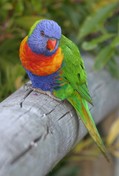 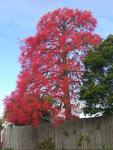
|
Rainbow Lorikeet Photos: K Vang and W Dabrowka / Bird Explorers © K Vang and W Dabrowka Image courtesy of the Australian Museum further reading: Birds in Backyards fact sheet Illawarra Flame Tree (Brachychiton acerifolius), is a large tree native to subtropical regions on the east coast of Australia. Along with other members of the Brachychiton genus, it is commonly referred to as a Kurrajong. |
Haiku #007: by Beverley George
First Published:
Haiku #010: by Jean Rasey
First Published:
The Green Catbird is a large, stout green bird, spotted white, with a dusky crown, nape and face and a white bill. The eye is red. Juveniles are duller in colour.
Haiku #011: by Janice M Bostok
First Published: A Splash Of Sunlight, Janice M. Bostok, 1998
Named after the Onga water pump due to a similarity between the pump's sound and the pigeon's monotonous call.
Haiku #012: by John Bird
First Published:

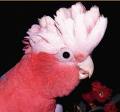
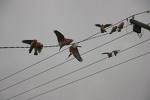
The 'Galah' or 'Rose-breasted cockatoo (Eolophus roseicapilla)
Haiku #013: by Jacqui Murray
First Published:
[--------- details later ------------]
Haiku #016: by Janice M Bostok
First Published: A Splash Of Sunlight, Janice M. Bostok, 1998


Haiku #016: by Nathalie Buckland
First Published: Stylus Poetry Journal, 2006
Haiku #017: by Carla Sari
First Published:
[--------- details later ------------]
Haiku #018: by Maureen Sexton
First Published:
[--------- details later ------------]
Haiku #019: by Lorin Ford
First Published: Stylus, July 2006. Also in her collection, A Wattle Seedpod, 2008
Haiku #020: by John Bird
First Published: New Zealand Poetry Society 2002 Anthology
Haiku #021: by Janice M Bostok
First Published:
Queenslander
Queenslander (or Old Queenslander) architecture is a style common throughout Queensland. Buildings are identifiable by large verandahs and large double doors which open onto these verandahs. They are typically raised on stumps firstly to elevate the houses for ventilation and secondly to protect them from floodwaters, as well as termites and other pests. Most Queenslanders were typically built of wood but with corrugated iron roofs.
They are popular with cane farmers and are commonly seen in a mown area surrounded by cane.
The taipan is a highly venemous and aggressive snake that often makes its home in canefields (until they are fired prior to harvesting).
Haiku #023: by Jack Prewitt
First Published:
Old Shep
A lament written by Red Foley about a faithful sheep dog. It was famously recorded by Walter Brennan and Elvis Presley and, in Australia, by Tex Morton."When I was a lad
And Old Shep was a pup
Over hills and... "
Haiku #024: by Alma E Bird
First Published:
[--------- details later ------------]
Haiku #025: by Jacqui Murray
First Published:
Ute
"Ute" is an abbreviation of "utility vehicle", as used in expressions such as "the holden ute". ('Holden' is an Australian make of vehicle.) It is a light truck with an open body and low sides and a tailboard. It is similar to, but smaller than, what is known as a "pickup" in some countries.
Haiku #026: by Lorin Ford
First Published: paper wasp Jack Stamm Award anthology May 2007
kelpie
The Australian Working Kelpie as a sheep dog is capable of tirelessly working in blistering heat, freezing cold and over great distances for days on end,
a good kelpie is said to be worth many men, particulary in mountain conditions or over vast areas.
Haiku #027: by John Bird
First Published: Yellow Moon Vol15, 2004
Swag/Swaggie
A swag (Australian slang) is a bedroll carried by a swaggie, an itinerant/hobo; and an Australian icon. A swag was also known as a bluey, as in "hump the bluey", and as a matilda, as in the song Waltzing Matilda.See entry in Wikipedia.
The Long Paddock -- a stock route or open road where people too poor to own paddocks, or any cattleman in times of drought, could drove their stock to graze them.
Haiku #029: by John Bird
First Published: The Dreaming Collection 2008
Sheep
At the time when its economy depended heavily on the export sales of merino wool, Australia was said to "live off the sheep's back".
Sheep are shorn in late spring, in a shearing shed.
Haiku #030: by Allison Millcock
First Published:
Haiku #032: by Graham Nunn
First Published:
Haiku #035: by Alma E Bird
First Published:
Dingo
A wolf-like, yellowish-brown, wild dog, native to Australia.
Image Courtesy of Photos of Australia copyright © southernson.com All Rights Reserved
Haiku #038: by Lorin Ford
First Published: Shiki Monthly Kukai June 2005 (first place); Shiki Salon Annual Haiku Awards, Free format section, 2005 (first place)
Haiku #039: by John Bird
First Published:
Haiku #040: by Vanessa Proctor
First Published:
Haiku #045: by Nathalie Buckland
First Published: Stylus Poetry Journal, 2006
Wallaby
A member of the Macropodidae family. Most genera resemble small kangaroos.
Red-knecked Wallaby
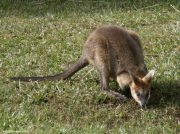
Image Courtesy of and © Southernson Photos of Australia
on the wallaby (track) is colloquial for 'on the move',
often applied to seasonal workers or swaggies.
Haiku #046: by Janice M Bostok
First Published:
The moth in this haiku is almost certainly a BOGONG moth.
Entry for: Australian Bogong Moth (Agrotis infusa)
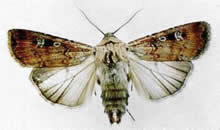
Photo: D Herbison-Evans; Copyright © Australian Museum
Tens of millions of Australian bogongs head south in late spring, from breeding grounds in southern Queensland on their 2-3,000km journey, by night, to spend summer in cool caves of the Southern Alps.
Haiku #049: by John Bird
First Published: Aleksandar Nejgebauer Haiku Club, Yugoslavia - 2000 competition
Water Dragon
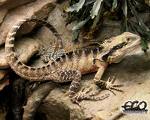
The Australian Water Dragon grows to almost four feet, has a large head, jowl and a spiny crest.
It runs like a dinausor. Sunning or catching insects, it is motionless while waiting.
It hibernates in winter, and re-emerges in spring.
Please use "Back" button to return to haiku.
Haiku #050: by Alma E Bird
First Published:

Auatralian Red-eyed Tree Frog (Litoria chloris )
Haiku #052: by John Bird
First Published: Stylus Issue 24, January 2007
The Bunyip was one of the magical beasts in Aborigines’ Dreamtime stories. It lived in swamps and billabongs, had a terrifying bellow, and devoured invaders of its territory.
European settlers, attributed strange sounds of the Australian bush to many mythical beasts, including the bunyip. However the settlers’ bunyips were more benign – herbaceous, shaggy animals. Some attribute the bunyip to crocidile sightings, some to fugitive swaggies who hid in swamps and emerged, covered with weeds, after the law had passed. The booming cry of the Australasian Bittern was often attributed to a bunyip.
Haiku #054: by Quendryth Young
First Published: Wollumbin Haiku Workshop June 2007
The commonest fruit bat in Australia, Asia and Africa is the Pteropus genus which has a foxlike head and feeds on fruit and blossom.
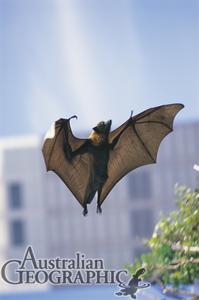 |
Grey Headed Flying Fox (Fruit Bat) Photographer: Grahame McConnell Image courtesy and © Australian Geographic |
Haiku #056: by Ken Daley
First Published: The Dreaming Collection, 2007
Aborigines, Indigenous Australians, have the longest continuous cultural history of any group of people on Earth. They are recognised to have arrived in Australia from 40,000 to 70,000 years ago.
There were 500-600 distinct groups of Aborigines speaking about 200 different languages or dialects (at least 50 of which are now extinct). [See: Answers.com]

Aborigine flag
'cast a long shadow' — somebody who was important was said to be 'a big man' and thence, to 'cast a long shadow.'
Haiku #058: by John Bird
From the sequence The Long Paddock first published in Songs of the Unsung Heroes, 2002, Australian Workers Heritage Centre.
DREAMING
" 'The Dreaming' or the 'The Aboriginal Dreamtime' is that part of aboriginal culture which explains the origins and culture of the land and its people.
Dreamtime is Aboriginal Religion and Culture." From Christalinks: more
Dot painting - the style of painting favoured by many Aborigines.
Yam - the edible tubor of a plant; a staple for many Aboriginal peoples.
Yam Dreaming paintings
Haiku # 59: by Lorin Ford
First published: Simply Haiku Winter 2006, vol 4 no 4
Haiku #060: by Quendryth Young
Published: The Dreaming Collection, 2007
Sacred Site / Lantana / MelaleukaA sacred site is a place that is thought of as sacred (or holy) to a particular religion. Every one of the world's major religions has them. The idea that some places are "sacred" or especially holy has existed for many thousands of years.
Aborigine sacred sites are usually natural sites where something of spiritual significance has occurred.
Lantana is a perennial flowering plant, imported to Australia where it is highly invasive and a noxious weed.
Melaleuca is a genus of plants in the myrtle family Myrtaceae. They are endemic to Australia. They are evergreen shrubs and trees, often with flaky, exfoliating bark. Larger species are known as paperbarks, and the smaller types as honey myrtles.
[image, more reading]
Haiku #063: by John Bird
Published: From the sequence The Long Paddock first published in Songs of the Unsung Heroes, 2002, Australian Workers Heritage Centre.
UluruUluru (formerly "Ayers Rock") is an Aboriginal sacred site located in the middle of Australia. It's the world's largest monolith, 10kms around the base and 348 metres high.
Image courtesy of Christalinks
A message from the traditional owners: Uluru
Haiku #063: by John Bird
From the sequence, The Long Paddock, first published in Songs of the Unsung Heroes, 2002, Australian Workers Heritage Centre.
Interpreter - 'Stolen Generation' The poem alludes to the "Stolen Generation", the forceful taking by government and religous organizations, of indiginous children from their families. Raised within white institutions and families, they lost their Aboriginal culture and many lost their native language.
Further reading: essay by Robert Mann and
statement of Government position
Arrernte These Aborigine people live in the desert areas of central Australia near Alice Springs. Their language, Arrente, is spoken by about 3,000 people. details
Haiku #064: by Vanessa Proctor
Published: Haiku Hut/Short Stuff -- February 2004
Haiku #065: by Lorin Ford
Published: a maple leaf, the 8th paper wasp Jack Stamm anthology, 2006
DIDGERIDOOThe didgeridoo (or didjeridu) is a wind instrument of the Indigenous Australians of northern Australia. It is sometimes described as a natural wooden trumpet or "drone pipe". Musicologists classify it as an aerophone.
There are numerous names for this instrument among the Aboriginal people. Yirdaki, also sometimes spelt yidaki, refers to the specific type of instrument made and used by the Yolngu people of north-east Arnhem Land. "Didgeridoo" is considered to be an onomatopoetic word of Western invention.
Further reading: iDIDJ Australia and WikipediA
Haiku #066: by Carolyn Cordan
Published: The Dreaming Collection 2007
SORRY DAYThe first National "Sorry Day" was held on 26 May 1998. Sorry Day offered the community the opportunity to be involved in activities to acknowledge the impact of the policies of forcible removal on Australia's Indigenous populations. A huge range of community activities took place across Australia on Sorry Day in 1998.
On Sunday 28th May 2000 more than 250,000 people participated in the Corroboree 2000 Bridge Walk across Sydney Harbour Bridge. The event highlighted the issue of a lack of an apology by the Commonwealth Government to the Stolen Generations.
In 2005 the National Sorry Day Committee renamed Sorry Day as a National Day of Healing for all Australians: 'The Day will focus on the healing needed throughout Australian society if we are to achieve reconciliation' (Extract from the National Sorry Day Council Archives: Senator Aden Ridgeway).
The National Day of Healing is an annual event, with marches, speeches and presentations held through the country.
On the 13th of February 2008, the Prime Minister, Kevin Rudd, tabled a motion in parliament apologising to Australia's Indigenous peoples, particularly the Stolen Generations and their families and communities, for laws and policies which had 'inflicted profound grief, suffering and loss on these our fellow Australians.'
[The above is extracted from the Australian Government Cultural and Recreational Portal recommended for further reading.]
Haiku #072: by Nathalie Buckland
First published: The Dreaming Collection 2008
Port Arthur

The green rosella is endemic to Tasmania.

Entry for: Anzac
"ANZAC Day - 25 April - [autumn] is probably Australia's most important national occasion. It marks the anniversary of the first major military action fought by Australian and New Zealand forces during the First World War. ANZAC stands for Australian and New Zealand Army Corps. The soldiers in those forces quickly became known as ANZACs, and the pride they soon took in that name endures to this day."
"Australians recognise 25 April as an occasion of national commemoration. Commemorative services are held at dawn, the time of the original landing, across the nation. Later in the day ex-servicemen and women meet and join in marches through the major cities and many smaller centres. Commemorative ceremonies are held at war memorials around the country. It is a day when Australians reflect on the many different meanings of war."
-- from the Australian War Memorial webpage: The Anzac Day Tradition
Please use "Back" button to return to haiku.
Haiku #075: by Ross Clark
First Published:
As part of the dawn memorial services held on Anzac Day, a bugler sounds the last post at the break of dawn.
Please use "Back" button to return to haiku.
Haiku #081: by Beverley George
First Published: [later]
Please use "Back" button to return to haiku.
Haiku #083: by Quendryth Young
First Published: Presence #33 September 2008
CRICKET
How to briefly explain the sport of 'cricket' to anybody who hasn't grown up playing it in the backyard or street? WikipediA makes a good effort but it isn't brief.
Referring to this haiku:* padding up – the next batsman due to play is putting protective pads on his legs; or, the batsman does not play at the ball but uses his padded legs to protect his wicket. (well, something like that)
* seagulls – flocks of seagulls often settle and feed on the huge oval-shaped playing arena while a game is in progress; when there is a wind they all face into it – here the wind is from the direction of the city.
Please use "Back" button to return to haiku.
Entry for: Cricket (a summer sport)
How to briefly explain the sport of 'cricket' to anybody who hasn't grown up playing it in the backyard or street? WikipediA makes a good effort but it isn't brief.
Referring to this haiku:* padding up – the next batsman due to play is putting protective pads on his legs; or, the batsman does not play at the ball but uses his padded legs to protect his wicket. (well, something like that)
* seagulls – flocks of seagulls often settle and feed on the huge oval-shaped playing arena while a game is in progress; when there is a wind they all face into it – here the wind is from the direction of the city.
Please use "Back" button to return to haiku.
Haiku #087: by Sharon Dean
First Published: Yellow Moon, No 17, 2005
HILLSHOIST -- a rotary clothes line.
"It was popularised in Australia by Lance Hill and is a common sight in Australian and New Zealand backyards. It is considered one of Australia's most recognisable icons, and is used frequently by artists as a metaphor for suburbia in Australia." [ Wikipedia]
and see GNT History
The "Hills Rotary Hoist" become an emblem of Australian enterprise.
Please use "Back" button to return to haiku.
Entry for: Groper
The Eastern blue groper (Achoerodus viridis) is a large fish found in the southern, coastal waters of Australia, especially exposed reefs.


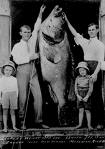
There are two species. Eastern blue gropers have been known to grow to 1.2 metres (4 ft) in length and weights of 22 kilograms. The western species is larger, reaching 1.6 m and 40 kg.
The blue groper is a member of the wrasse family and should not be confused with the Queensland gropers (Epinephelus).Please use "Back" button to return to haiku. [--------- details later ------------]Please use "Back" button to return to haiku.
Haiku #088: by Nathalie Buckland
First Published: Paper Wasp (Jack Stamm Anthology), 2005
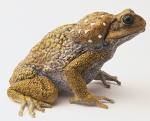
Cane Toads are opportunistic predators and will eat whatever mouth-size prey they can capture. Although Cane Toads are native to Central and South America, these voracious toads have been introduced to other places around the World, such as to Australia, in ill-considered attempts to control crop pests. These huge toads can afford to be rather calm and nonchalant as they hop across the grass because they are quite poisonous. The large bulge behind the eye is a poison gland. [from 'The firefly Forest']
[Ed: probably soccer goal posts, such as these]
Please use "Back" button to return to haiku.
Haiku #091: by John Bird
First Published: The Dreaming Collection, 2007
Kookaburra (an Australian bird)
"The chuckling voice that gives this species its English name is a common and familiar sound throughout the bird's range. The loud 'koo-koo-koo-koo-koo-kaa-kaa-kaa' is often sung in a chorus with other individuals." -- from Australian Museum Fact Sheet: Laughing Kookaburra.
Kookaburra
Photo: G Threlfo/Nature Focus © Australian Museum
Image courtesy of Australian Museum
Please use "Back" button to return to haiku.
Haiku #092: by Lorin Ford
First Published: Stylus Poetry Journal, April 2006
Please use "Back" button to return to haiku.
Haiku #093: by Ross Clark
First Published: [later]
Southern Cross
A star constellation prominent in the southern hemisphere. It appears on the Australian Flag.
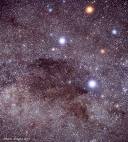
Please use "Back" button to return to haiku.
Haiku #094: by Vanessa Proctor
First Published: [later]
Port Fairy is on the coast of Victoria. Initially it was a whaling station, then a significant port and fishing harbour. In recent years it has become noted for its cultural festivals.
Please use "Back" button to return to haiku.
Haiku #095: by Lorin Ford
First Published: paper wasp Vol. 11 no 4 Spring 2005
Please use "Back" button to return to haiku.
Haiku #099 by: Jack Prewitt
First published: The Dreaming Collection, 2008Bulldust
1. Fine talcum powder-like red dust, found in outback Australian tracks. When wet it forms a sticky and gelatinous bog that defeats most cars.
When dry it is deceptively difficult and dangerous to drive on; it clogs air filters, and invades the human body, especially the throat.
2. In Australian slang: Nonsense; blatantly false statements. [Synonym: Bullshit]
Please use "Back" button to return to haiku.
Haiku #092: by Alma E Bird
First Published:
Please use "Back" button to return to haiku.